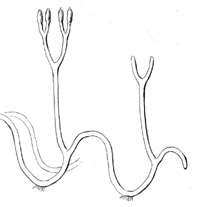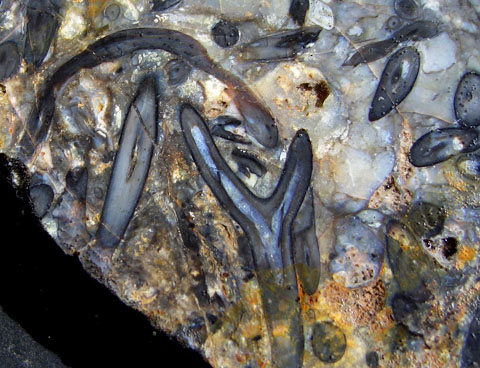A peculiar way of creeping -
Aglaophyton
reconsidered
The most common plant in the Rhynie chert, as often pictured lately,
forms arches along the ground from which the upright shoots emerge. The
arching growth is said to be brought about by upright shoots falling
over when becoming unstable with increasing height [1]. This view,
perhaps suggested by the aspect of brambles, has not been disputed
since the plant formerly known as Rhynia
major was re-named
Aglaophyton
in 1986 [1].
Doubts arise in view of the fact that Aglaophyton does
not look limp
and slender with upright shoots about 5mm across and with an assumed
height of mere 20cm. Extant plants with such measures are rather
sturdy. The doubts are confirmed by fossil evidence: From the rare
cases where an arch is incidentally cut lengthwise it becomes obvious
that such arches can be so small that they cannot be explained by
falling over. The drawing in Fig.2 shows how the half arch seen in
Fig.1 may be explained by one prong of the forking axis growing
downwards. (The down direction in Fig.1 is indicated by rhizoids seen
on a cross section near the end of the arch.) Another example is shown
in Fig. 3.



Fig.1, far left: Aglaophyton
axis turning sharply downward, arch radius
about 1cm.
Fig.2, left: Principle of arch formation without
falling over.
Fig.3,
right: In-plane section of arching and forking
axes incidentally
seen on the natural surface of a
Rhynie chert sample, arch radius
about 1.5cm.
A photograph of an upward bend is shown here.
So it can be concluded that Aglaophyton
did not fall over as claimed in
[1] but grew downwards to touch the ground, grow rhizoids, and turn
upwards again. (This conclusion was first presented at the 3rd
Chert Meeting, Chemnitz 2004.)
It would be interesting to know if there were or
still are other arching creepers applying this peculiar way of
propagation invented by Aglaophyton.
H.-J. Weiss
2008
[1] David
S. Edwards,
Aglaophyton
major, a non-vascular
land-plant from the Devonian Rhynie Chert,
Bot. J. Linn. Soc. 93(1986), 173-204.
 |
 |
14 |






